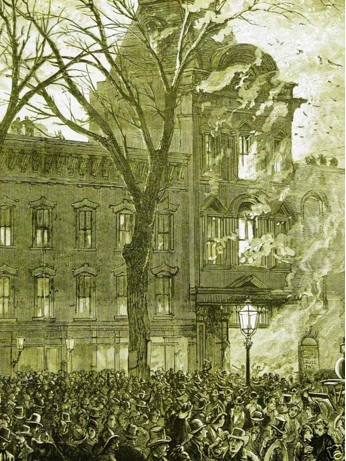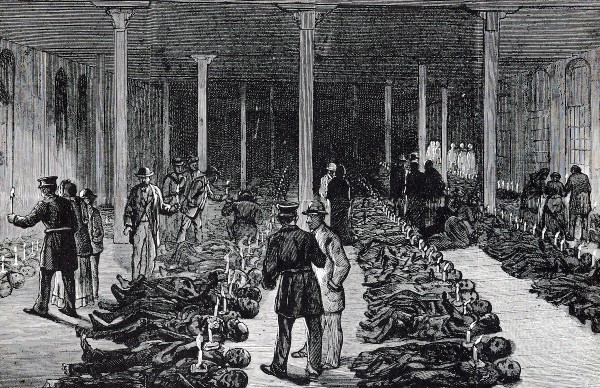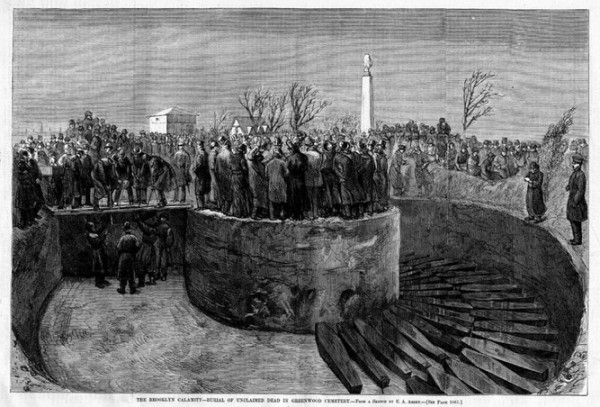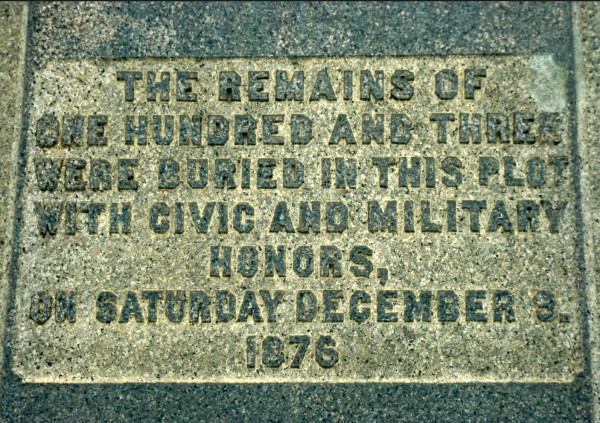There is always more to know.
On the night of December 5, 1876, the Brooklyn Theatre in downtown Brooklyn was packed with one thousand patrons. Then the fire began–and soon the building collapsed. But, still, it was thought that few lives had been lost. But, the next morning, when firemen began to sift through the wreckage, they came across body after body. By the time they were done, 278 bodies had been found. More lives were lost that night than in any other on-land disaster in what is now New York City–until the 9/11 attacks on the World Trade Center more than a century later.
I know quite a bit about the Brooklyn Theatre Fire and the monument to it at Green-Wood. I have read many newspaper accounts of that disaster. I have seen many woodcuts and 19th-century photographs of the fire, its aftermath, and Green-Wood’s Brooklyn Theatre Fire Monument. Here’s a recent photo I took of it:

And here’s a woodcut of the Brooklyn Theatre, on fire, on the evening of December 5, 1876.

A morgue was created, with the hundreds of bodies laid out:

Just days after the fire, dozens of hearses lined up at Green-Wood as the “coffins were placed in a double row with the heads pointing inwardly” in a “radiating double circle.”
Within a week of the deadly fire, Mayor Frederick A. Schroeder (who is interred at Green-Wood) and Brooklyn’s Common Council were discussing their plans to build a monument . Note that the ground upon which the monument would ultimately be erected was not dug, but was left intact–that would provide a solid base for the planned monument and prevent settling of the soil there.

I was recently contacted by Danny Devlin, a PhD candidate at the Department of Theatre of the University of Kansas. Danny has been working on his dissertation; its subject is memorials to those who died in theatre fires. And one of the monuments Danny has researched is that to the Brooklyn Theatre Fire and its victims.
Danny has identified two monument makers who were hired, in succession, to build the Brooklyn Theatre Fire Monument. On December 2, 1879, almost three years after this disaster, The New York Times reported that “Robert F. McKellar (sic) was awarded the contract yesterday by the [Brooklyn] Common Council for erecting a monument over the grave of the victims of the Brooklyn Theatre fire, which occurred Dec. 5, 1876. The monument is to cost $3,830.” MacKellar did quite a bit of work at Green-Wood, and is himself buried there. Here is an example of his letterhead from Green-Wood’s archived burial orders:

But it appears that MacKellar never proceeded with the monument. Perhaps his bid had been too high; perhaps there was some kind of deal made with another monument maker. In any event, in a notice dated January 19, 1880, just weeks after the contract was awarded to MacKellar, Brooklyn’s Department of City Works again advertised for proposals “for furnishing and erecting a monument in the plot of ground owned by the city in Greenwood (sic) Cemetery.” And, it was added, all proposals were to include bids for a monument with and without steps. Less than a month later, the Brooklyn Union-Argus reported that the low bid had come in at $5,830. But, as the Union-Argus noted, there was a problem: Brooklyn had appropriated only $2000 for the monument. So negotiations ensued between Brooklyn and at least one monument maker–David S. Arnott–for a reduced price.
On March 2, 1880, The New York Times reported this Brooklyn news: “The Board of City Works was directed by the Common Council yesterday to award the contract for erecting a monument to the victims of the Brooklyn Theatre fire to ex-Alderamn D. S. Arnott, who was the lowest bidder.” Arnott, who clearly had political connections–in addition to having been an alderman, he had served as Brooklyn Assessor– now had entered the winning low bid of $2,680. And, it appears that Arnott was also the designer of the monument: according to the report of the Union-Argus, Arnott asked to be paid for the plans he had himself prepared: he “drew his plans by order of the Engineer . . . .” Arnott also is interred at Green-Wood.


The Brooklyn Fire Monument was unveiled and dedicated in November, 1880, almost four years after the fire. It is a huge obelisk of gray “tooled granite” with “a plinth, sub-base, die and capital” rising 30 feet. “Stenciled bands of polished stylized leaves and vines” adorn it. Inscriptions of each of the four sides describe the Brooklyn Theatre Fire. Here is one of them:

And “a fence consisting of stone posts and a metal railing encompassed the plot.” The fence was vandalized some years ago–several of its rails were stolen–and it then was removed. But the Brooklyn Theatre Fire Monument still stands, not far from Green-Wood’s main gates, in tribute to those who died on the evening of December 5, 1876, when their night out at the theatre became tragedy.
Great thanks to Danny Devlin for kindly sharing his stellar research and his dissertation with me. It is greatly appreciated!
greetings. Robert MacKellar was my great great grand-uncle. I was wondering if it was known what monuments he or his company worked on. Are there any records for the Monumental Granite Company?
Very interesting! I do not know of existing records for Monumental Granite. Nor do we have a full inventory of his work at Green-Wood–if we learn of his work, it is one monument at a time.
Thank you for this additional detail. I have an ancestor among the 103 buried here (and two others also lost in the fire whose remains were identified buried nearby). The fire and its aftermath of course left an indelible imprint on my family for generations. Learning more about every aspect, including the construction of the monument itself, is a gift. I have visited the monument, but did not know some of the background you provide here. Thank you!
Hi Paul,
Glad you enjoyed it!
Please share with me the names and lot numbers for those you have mentioned. I would like to include them in our information about this tragedy.
-Jeff Richman
Green-Wood Cemetery Historian